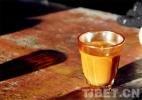Nov. 23, 2016 -- Lhasa is known as the holy snowy city. The pilgrims who come and go from here and the tourists from all over the world bring vitality to the pious atmosphere. This can be felt from the smoke curling up on the Barkor Street and the aromas drifting from the teahouses.
The Barkor Street lies in Lhasa’s old district and preserves the traditional Tibetan way of living and architectural style. The earliest Barkor Street was a circumambulation path centered on the Jokhang Temple for worshipping the 12-year-old Sakyamuni statue. Tibetan people see this as a holy path and many people come here from far and wide just to get a glimpse of the Buddha.
At the end of Potrang Saba Alley in the Barkor Street, there is an ancient yellow building. There is a teahouse in the courtyard which was named the Yellow Teahouse due to its color. Every day, Yangjen Tsering and his wife, who are the bosses here, cook Tibetan noodles and brew sweet tea for their guests. Tibetan people are accustomed to going to the teahouse in the morning to drink sweet tea and talk with neighbors, a custom that is still in place today. At around half past seven in the morning, the first round of customers are sitting in the teahouse ordering Tibetan noodles and cups of sweet tea. Yangjen Tsering’s wife passes them their cups with a smile and fills them with sweet tea. The rising hot air brings an instant warmth to the place.
Yangjen Tsering cooks Tibetan noodles in the kitchen near the backdoor. He grabs a bunch of noodles and places it in the boiling water. He then mixes it many times with chopsticks and fills the bowls with cooked noodles. After adding a big spoon of hot beef soup, some diced meat and scallions, a bowl of delicious Tibetan noodles is served to the customers.
Yangjen Tsering said that he loves eating and cooking Tibetan noodles and the teahouse has been opened for 9 years now. The two rooms used for the teahouse are part of their own house, so they don’t need to pay the rent. The net income isn’t bad too, as they can support their two sons through college as well as buy a new house. The yellow houses were mostly used as places of religion in the past. Legend has it that the 6th Dalai Lama stayed here when slipping out of the Potala Palace in the evening. Even after 700 years, this historical building has still been preserved as a cultural relic. Today, business at Yangjen Tsering’s teahouse improves day by day as he catches the wave of tourism.
"The Yellow Teahouse is the hero of our family, we must say thanks to it and manage it well," said Yangjen Tsering.





